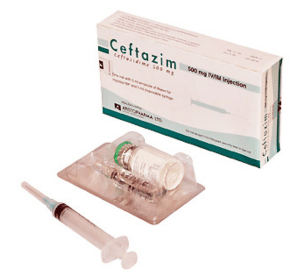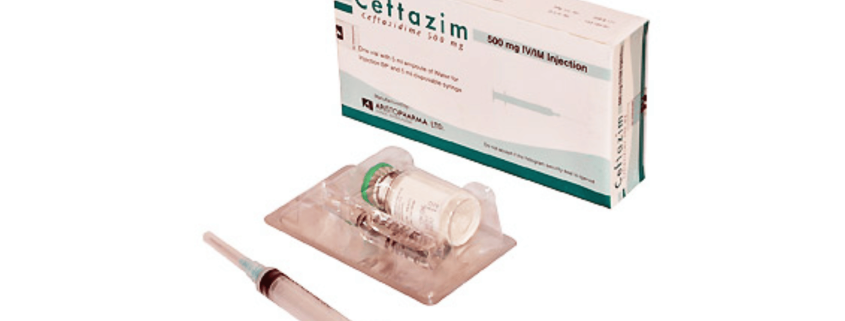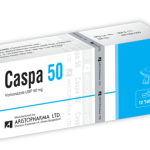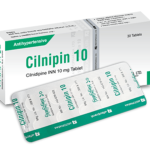Ceftazim (Ceftazidime)

Therapeutic Group : Antibiotic
Presentation:
Ceftazim 250 mg IV/IM Injection: White to faintly yellow powder in vials containing 250 mg of Ceftazidime (as pentahydrate), with sodium carbonate.
Ceftazim 500 mg IV/IM Injection: White to faintly yellow powder in vials containing 500 mg of Ceftazidime (as pentahydrate), with sodium carbonate.
Ceftazim 1 g IV/IM Injection: White to faintly yellow powder in vials containing 1 g of Ceftazidime (as pentahydrate), with sodium carbonate.
Indications:
Ceftazim is indicated for the treatment of patients with infections caused by susceptible strains of the designated organisms in the following diseases-
Severe infections in general: Septicaemia, bacteraemia, peritonitis, meningitis, infection in immuno-suppressed patients with hematological or solid malignancies, and in patients with cystic fibrosis.
Respiratory tract infections: Pneumonia, bronchopneumonia, infected pleurisy, emphysema, lung abscess, infected bronchiectasis and bronchitis and in lung infection in patients with cystic fibrosis.
Ear, nose and throat infections: Otitis media, malignant otitis extrema, mastoiditis, sinusitis and severe car and throat infections.
Skin and skin structure infections: Erysipelas abscesses, cellulitis, infected burns and wounds, mastitis, skin ulcers.
Bone and joint infections: Osteitis, osteomyelitis, septic arthritis, infected bursitis.
Urinary tract infections: Acute and chronic pyelonephritis, pyelitis, prostatitis, cystitis. Urethritis (bacterial only), renal abscess and infections associated with bladder or renal stones.
Gynecologic infections: Endometritis, pelvic cellulitis and other infections of the female genital tract caused by Escherichia coli.
Gastrointestinal, billary and abdominal infections: Cholangitis, cholecystitis, emphysema of gall bladder, intra-abdominal abscesses, peritonitis, diverticulitis, ceterocolitis, post-partum pelvic inflammatory conditions.
Dialysis: Infections associated with haemo and peritoneal dialysis and with continuous ambulatory peritoneal dialysis(CAPD)
Dosage & Administration:
The dose of Ceftazim depends upon the severity, sensitivity and the type of infection.
Adults: 1 g every 8 hours or 2 g every 12 hours. In severe infections, 2g every 8-12 hours. In the elderly usual max. dose is 3 g daily.
Child (Up to 2 months): 25-60 mg/kg daily in 2 divided doses.
Child (Over 2 months): 30-100mg/kg daily in 2-3 divided doses, up to 150mg/kg daily (max. 6g daily) in 3 divided doses. In case of meningitis or immunocompromised patients, IV route is recommended for children.
Urinary-tract and less serious infections: 0.5-1 g every 12 hours.
Pseudomonal lung infection in cystic fibrosis: Adult with normal renal function 100-150 mg/kg daily in 3 divided doses. Child: Up to 150 mg/kg daily (max 6 g daily) in 3 divided doses.
Surgical prophylaxis: 1 g at induction of anaesthesia in prostatic surgery, repeated if necessary when cather is removed.
Preparation of solution for intramuscular/intravenous injections:
For IM injection: Add 1 ml & 1.5 ml water for injection BP with Ceftazim 250 mg & 500 mg receptively. Then shake gently to disperse. For IV injection: Add 2.5 ml & 5 ml water for injection BP with Ceftazim 250 mg & 500 mg receptively to make solution. The injection should be administered by deep intramuscular or by show intravenous injection over 3-5 minutes. The use of freshly reconstituted solution is recommended. However, it maintain potency for at least 18 hours if keep below 25°C & 7 days if kept in a refrigerator.
All sizes of vials as supplied are under reduced pressure. As the products dissolves, carbon dioxide is released and a positive pressure develops. For ease of use, it is recommended that the following techniques of reconstitution are adopted.
Contrainidications:
Ceftazim is contraindicated in patients with known hypersensitivity to cephalosporin antibiotics.
Warning & Precautions:
Cephalosporin antibiotics at high dose should be given with caution to patients receiving concurrent treatment with nephrotoxic drugs e.g. aminoglycoside antibiotics or potent diuretics such as furosemide.
Side effects:
GI upsets, CNS effects, phlebitis or thrombophlebitis at IV injection site, very rarely hypersensitivity reaction. Transient haematological changes may occur.
Use in special groups:
Use in pregnancy & lactation: There is no experimental evidence of embryopathic or teratogenic effect attributable to Ceftazim but like other drugs is should be administered with caution during the early month of pregnancy. Ceftazim is excreted in milk in less concentration. There would appear to be little risk to breast feed infant.
Packing:
Ceftazim 250 mg IV/IM Injection: Combipack of 1 vial of 250 mg of Ceftazidime USP and 1 ampoule of 5 ml Water for injection.
Ceftazim 500 mg IV/IM Injection: Combipack of 1 vial of 500 mg of Ceftazidime USP and 1 ampoule of 5 ml Water for injection.
Ceftazim 1 g IV/IM Injection: Combipack of 1 vial of 1 g of Ceftazidime USP and 1 ampoule of 10 ml Water for injection.



